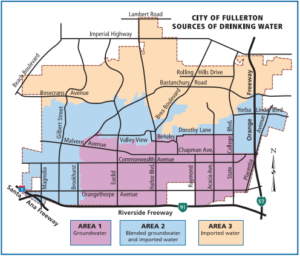Frequently Asked Question
Toggle
Lime, also known as calcium carbonate (CaCO3), can be present in tap water as a dissolved mineral.
-
Natural Occurrence: Lime is a naturally occurring mineral found in many geological formations. When water comes into contact with these formations, it can dissolve and carry calcium carbonate into the water supply.
-
Effects of Lime in Tap Water:
-
Scaling: One of the primary effects of high lime content in water is the formation of scale. When hard water is heated, such as in a water heater or kettle, the calcium and magnesium ions can precipitate out of the water and form scale deposits on surfaces like heating elements and plumbing fixtures. This scale can reduce the efficiency of appliances and pipes.
-
Soap Scum: Hard water can also lead to soap scum formation when soap reacts with calcium and magnesium ions. This can result in soap residue on dishes, glassware, and shower surfaces.
-
Reduced Lathering: Hard water can make it more difficult to create lather with soap, shampoo, and detergents, leading to the need for larger amounts of cleaning products.
-
Potential Taste and Odor Issues: Some people may detect a slightly different taste or odor in hard water compared to soft water. This is not harmful but can be a personal preference issue.
-
FAQ
Journey to great water
NOW we are started journey from current Tap water to be a great water, It will start from understanding water source, testing, filtering, softening etc…
 Most US city water quality report find by googling
Most US city water quality report find by googling
” City name water quality report ” example : this picture shows Fullerton, CA water source, quality etc.. find out your city.
-
Natural Sources:
- The water source itself can contain heavy metals and solids. For example, groundwater may naturally have higher levels of minerals like iron, manganese, and calcium. These minerals can dissolve into the water and become part of your tap water.
-
Industrial Pollution:
- In some areas, industrial activities can release heavy metals and solids into the environment. These pollutants can seep into groundwater or nearby water bodies, contaminating the water supply.
-
Agricultural Runoff:
- Agricultural practices can lead to the introduction of pesticides, fertilizers, and soil particles into water sources. These substances can find their way into tap water through runoff or infiltration.
-
Aging Infrastructure:
- Older water distribution systems with deteriorating pipes and plumbing can leach heavy metals like lead into the water. Corrosion of pipes can be a significant source of heavy metal contamination, especially when the water is corrosive.
-
Water Treatment Processes:
- In some cases, water treatment processes can inadvertently introduce solids or alter the chemical composition of the water, leading to the presence of heavy metals. For example, adding chemicals for disinfection can react with naturally occurring substances to form byproducts.
-
Environmental Factors:
- Environmental factors like erosion and sedimentation can introduce soil particles and other solids into water sources. Rainwater can wash soil and sediment into reservoirs and rivers, affecting the quality of the water supply.
To determine the specific heavy metals and solids present in your tap water and their concentrations, it’s essential to have your water tested. Contact your local water utility or a certified laboratory to perform a water quality test. They can provide you with a detailed analysis of your tap water and inform you of any potential issues.
If you discover that your tap water contains unsafe levels of heavy metals or solids, you may need to take action to improve its quality. This could involve using water treatment systems, like filters or water softeners, or working with your local water provider to address the source of the contamination.
It’s important to note that the presence of calcium in water is not generally a health concern, and calcium is an essential nutrient for the human body. However, the hardness of water and its effects on appliances and plumbing can be a concern for household maintenance and comfort.
-
Water Hardness: Calcium, along with magnesium, is a primary contributor to water hardness. Water hardness is a measure of the concentration of calcium and magnesium ions in water. High levels of calcium can make water “hard.” Water hardness can have several effects:
- Scale Formation: When hard water is heated, calcium ions can combine with bicarbonate ions to form calcium carbonate scale. This scale can accumulate on the inside of water heaters, pipes, and appliances, reducing their efficiency and lifespan.
- Soap Scum: Hard water can react with soap to form soap scum, which can leave a residue on dishes, glassware, and shower surfaces.
- Reduced Lathering: Hard water can make it more difficult to create lather with soap, shampoo, and detergents, requiring the use of larger amounts of cleaning products.
-
Taste and Odor: In some cases, water with higher calcium content may have a slightly different taste and odor compared to soft water. This is usually not a health concern but can be a personal preference issue.
-
Nutrient Source: Calcium is an essential nutrient for humans, and drinking water with calcium can contribute to your daily intake. However, the calcium content in water is usually relatively low compared to dietary sources like dairy products and leafy greens.
-
Beneficial for Plants: Calcium in water can be beneficial for plants when used for irrigation. It is an important nutrient for plant growth and can help improve soil structure in some cases. However, excessive calcium in irrigation water can lead to soil salinity problems.
-
Dissolved Calcium Minerals: Calcium can also be present in water in the form of dissolved minerals, such as calcium bicarbonate and calcium sulfate. The presence of these minerals can affect the water’s chemical composition and pH.
-
Corrosion Control: Calcium can play a role in controlling the corrosion of metal pipes and plumbing fixtures. It can form a protective layer on the inner surface of pipes, reducing the leaching of metals like lead into the water.
In areas with very hard water, homeowners may choose to install water softeners to reduce the calcium and magnesium content of their tap water. Water softeners replace calcium and magnesium ions with sodium or potassium ions, effectively reducing water hardness and mitigating some of the issues associated with hard water, such as scale formation and soap scum.
It’s important to note that the presence of calcium in water is not generally a health concern, and calcium is an essential nutrient for the human body. However, the hardness of water and its effects on appliances and plumbing can be a concern for household maintenance and comfort.
Which One to Choose:
-
Choose a salt-based water softener if: You have very hard water, want a noticeable improvement in water softness, and are willing to invest in regular maintenance and ongoing operational costs.
-
Choose a salt-free water softener if: You have moderately hard water and want to prevent scale buildup and protect your plumbing without altering the taste of your water. Salt-free systems are also a good choice for individuals concerned about sodium or potassium intake.
In summary, the choice between salt-based and salt-free water softeners depends on the hardness of your water, your budget, and your preferences regarding maintenance and taste. It’s essential to have your water tested to determine its hardness and consult with a water treatment professional to choose the best system for your needs.
Salt-Based Water Softeners:
-
How They Work: Salt-based water softeners use a process called ion exchange to remove calcium and magnesium ions (hardness minerals) from water. These ions are replaced with sodium or potassium ions, effectively “softening” the water.
-
Effectiveness: Salt-based water softeners are highly effective at reducing water hardness. They can provide complete hardness removal, resulting in water that feels noticeably softer and reduces issues like scale buildup on plumbing and appliances.
-
Maintenance: Salt-based systems require regular maintenance, including refilling the brine tank with salt or potassium pellets. The frequency of maintenance depends on water hardness and household water usage.
-
Cost: The initial cost of a salt-based water softener and ongoing operational costs for salt or potassium can be higher compared to salt-free alternatives.
-
Taste: Some people may detect a slight increase in sodium or potassium levels in softened water, which could be a concern for individuals on restricted diets. However, the increase is generally minimal and not a health concern for most people.
Salt-Free Water Softeners:
-
How They Work: Salt-free water softeners, often referred to as “water conditioners” or “descalers,” use various technologies such as Template Assisted Crystallization (TAC) or electromagnetic fields to alter the structure of hardness minerals, preventing them from adhering to surfaces.
-
Effectiveness: Salt-free systems do not remove hardness minerals from water but rather change their form to prevent scaling. They are less effective than salt-based softeners and are better suited for reducing scale buildup and protecting plumbing rather than providing a noticeable change in water feel.
-
Maintenance: Salt-free systems generally require less maintenance than salt-based systems because they don’t use salt or potassium pellets. However, some periodic cleaning or cartridge replacement may be necessary.
-
Cost: The initial cost of salt-free water conditioners is often lower than that of salt-based water softeners. Additionally, there are no ongoing costs associated with salt or potassium pellets.
-
Taste: Salt-free water softeners do not add sodium or potassium to the water, so there is no change in the taste of the water.
The cost of installing a water softener can vary widely depending on several factors, including the type of water softener you choose, the complexity of the installation, and your location. Here’s a rough estimate of the cost range for water softener installation:
-
Basic Water Softener: For a basic, entry-level water softener unit and installation in a straightforward location with minimal plumbing modifications, you might expect to pay anywhere from $500 to $1,500. This estimate typically includes the cost of the softener unit, basic plumbing work, and labor.
-
Mid-Range Water Softener: If you choose a mid-range water softener with more features and efficiency, the cost can range from $1,500 to $3,000 or more. The installation cost will also be higher due to the added complexity.
-
High-End Water Softener: High-end water softener units with advanced features and technology can cost $3,000 to $5,000 or more. The installation cost for these units may also be higher due to the need for precise setup and additional components.
-
DIY Installation: If you decide to install the water softener yourself, you can save on labor costs. However, you’ll still need to purchase the softener unit, plumbing materials, and any additional components. DIY installations can range from a few hundred dollars to over $1,000, depending on the quality and complexity of the system.
-
Additional Costs: Keep in mind that there may be additional costs, such as water testing fees (if required), permits, electrical work (if needed), and any optional components like pre-filters or bypass valves.
-
Ongoing Costs: Remember that, in addition to the initial installation cost, you’ll need to budget for ongoing expenses like salt or potassium pellets, maintenance, and potential repairs.
To get an accurate estimate for your specific situation, it’s recommended that you obtain quotes from local water softener installation professionals or companies. They can assess your water quality, the location of the installation, and any specific requirements unique to your home, which will help determine the precise cost.
Additionally, consider factors like the warranty and service offered by the installation provider, as well as the long-term cost savings associated with improved water quality and reduced maintenance for appliances and plumbing.
Call us consultation is free…
